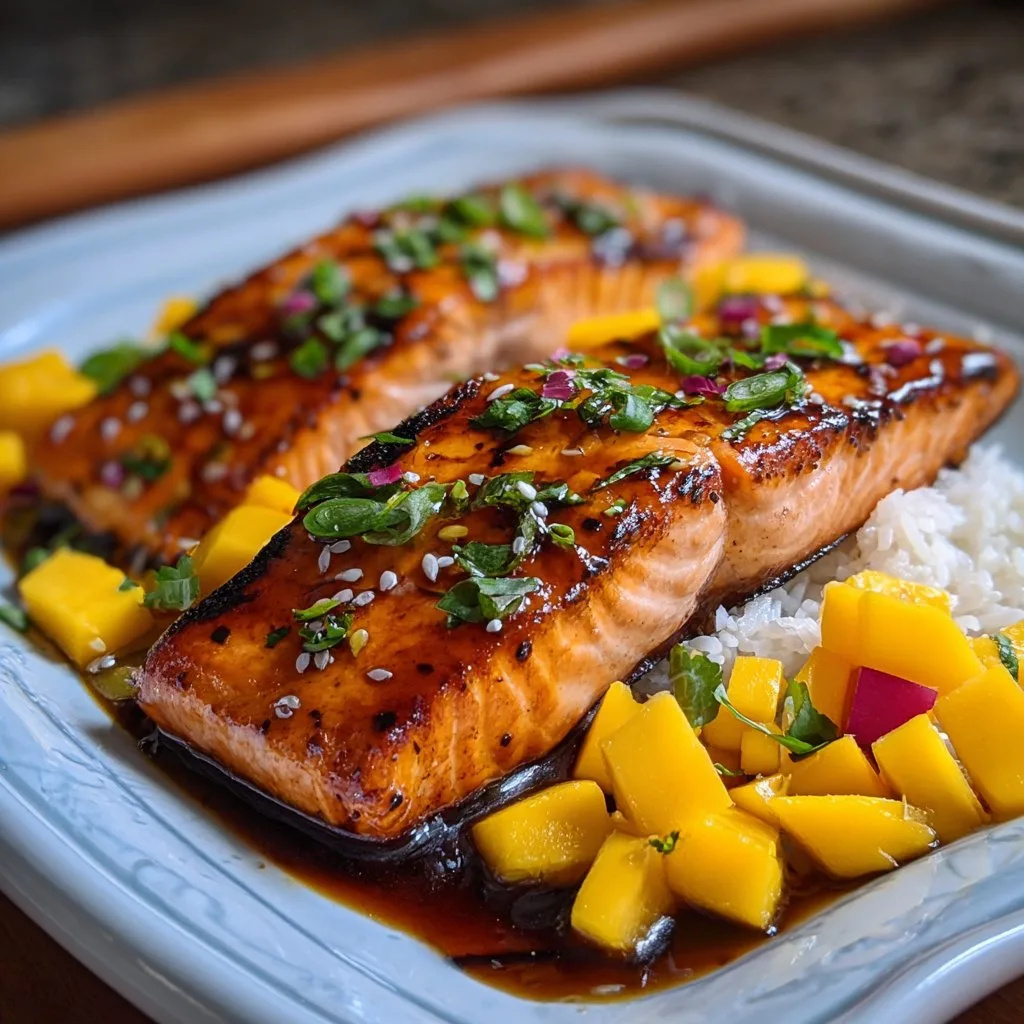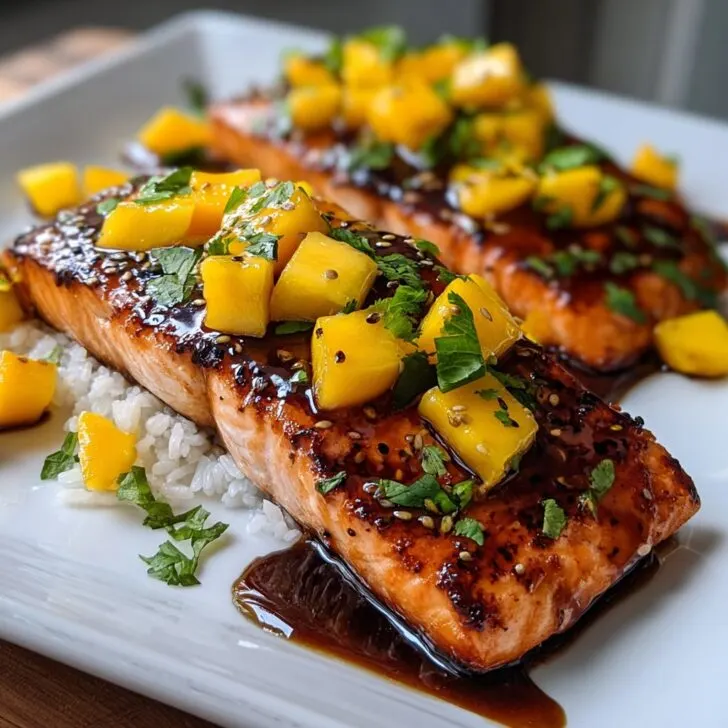If you popped by my kitchen on a Tuesday, you’d probably catch me whisking something glossy while the rice cooker hums and the dog stares like he pays the grocery bill. This Mango Teriyaki Salmon started as a what do I do with this very ripe mango situation, and now it’s one of those recipes I make on autopilot. The first time I served it, my brother said it tasted like summer put on a nice shirt. I’ll take it. Also, the night I finally nailed the sauce, the grocery store was playing nineties hits, so now I can’t slice a mango without quietly singing along. Not required, but highly encouraged.
Why I keep making this when I’m tired but hungry
I make this when I want shiny, sweet savory salmon that feels a bit special without a lot of faff. My family goes a little wild for it because the mango makes the teriyaki taste like a vacation, and the glaze sticks in the best way. And honestly, I used to scorch teriyaki at the edges and sulk about it; actually, I find it works better if I start the glaze on the stove and finish it on the fish. Less drama, more dinner.
What you’ll need, give or take
- 4 salmon fillets, about 150 to 180 g each, skin on or off if you’re not into crispy skin
- 1 ripe mango, peeled and diced small, plus a few extra slices for snacking while you cook
- 60 ml low sodium soy sauce or tamari if you want it gluten friendly
- 2 tablespoons honey or brown sugar if that’s what you have
- 1 tablespoon rice vinegar or apple cider vinegar in a pinch
- 1 tablespoon fresh grated ginger, roughly a thumb sized piece
- 2 garlic cloves, finely chopped, more if you love it
- 1 tablespoon neutral oil, like avocado or grapeseed
- 1 to 2 teaspoons toasted sesame oil for that toasty finish
- 1 teaspoon cornstarch mixed with 2 teaspoons cold water, for thickening
- A squeeze of lime, optional but lovely
- Sesame seeds and sliced scallions for topping
Substitutions I actually use: I sometimes use frozen mango when I’m in a hurry, just thaw and drain it. My grandmother always insisted on a particular soy sauce brand, but honestly any good one works fine. No rice vinegar around? White wine vinegar is okay, just use a touch less.
Alright, let’s cook
- Pat the salmon dry and sprinkle with a pinch of salt. Not much since the sauce has soy. Let it sit while you sort the sauce.
- Make the mango teriyaki: In a small saucepan, combine soy sauce, honey, rice vinegar, ginger, garlic, and half the diced mango. Bring to a gentle simmer over medium heat for about 4 to 5 minutes. Stir occasionally. This is where I usually sneak a taste and think oh yes, that’s it.
- Thicken it a bit: Stir the cornstarch slurry, then pour it into the simmering sauce and cook 30 to 60 seconds until glossy. Remove from heat, add the sesame oil and a squeeze of lime. Mash the softened mango pieces with a spoon so the sauce gets fruity and smoothish. Don’t worry if it looks a bit weird at this stage, it always does.
- Heat a large skillet with the neutral oil over medium high. When it’s hot, lay in the salmon, pretty side down first if skinless. If there’s skin, start skin side down, it helps prevent sticking.
- Cook the salmon 3 to 4 minutes until you get some color. Flip gently. Cook another 2 minutes.
- Spoon on a couple tablespoons of the mango teriyaki and scatter the remaining fresh mango bits into the pan. Let it bubble around the fish for 1 to 2 minutes so it glazes but doesn’t burn. If it threatens to catch, lower the heat; the sugars are enthusiastic.
- Option to finish in the oven for thicker fillets: slide the skillet into a hot oven at 200 C for 4 to 6 minutes until the salmon flakes at the edges but is still juicy in the center. Remove form the oven carefully.
- Taste the sauce in the pan. If it needs a pinch of salt or a whisper more vinegar, go for it. On second thought, a tiny extra squeeze of lime right at the end is really nice.
- Sprinkle with sesame seeds and scallions. Serve immediately while glossy and smug.
Little notes I wish someone told me
- If your mango is rock hard, pop the diced bits in the microwave for 20 seconds to soften before they go into the sauce. Works a treat.
- Use a nonstick or a well seasoned pan if you can. Stainless is fine, but give the fish time to release on its own. Y’all, patience here is gold.
- I think this tastes even better the next day cold over greens, though I also say it’s best hot off the pan, so take that contradiction with a grain of salt.
- New to cutting mango without wrestling it The step by step from the National Mango Board is handy: how to cut a mango.
Variations I tried so you dont have to
- Spicy version: add a teaspoon of sriracha or a pinch of chili flakes to the sauce. It wakes everything up.
- Coconut glaze: swap half the soy for coconut aminos and finish with a splash of coconut milk. It gets lush and a bit tropical.
- Ginger heavy: doubled the ginger once, and it was punchy in a good way, but my kids side eyed me. So maybe one and a half and call it a day.
- What didn’t work: tried canned mango puree that had added sugar, the sauce went overly sweet and kind of flat. Fresh or frozen mango is better.
- Different protein: this glaze loves chicken thighs and tofu too, just adjust the cook time. Trout works but felt a tad delicate for the sticky glaze.
Gear I use, but you can improvise
I swear by a large oven safe skillet so I can sear then finish in the oven. That said, if you only have a sheet pan, brush the salmon with oil, roast at 200 C for 8 to 12 minutes, and warm the sauce separately on the stove before spooning it over. No microplane for ginger Grate it on the small holes of a box grater, or mince it and call it good.

Storing leftovers without fuss
Let the salmon cool, then tuck it into an airtight container with any extra glaze. Fridge for up to 2 days, though honestly, in my house it never lasts more than a day. Its lovely flaked over rice bowls or a quick salad. Reheat gently on low heat or eat it cold straight form the fridge if you’re feeling bold.
How we like to serve it
Steamy jasmine rice is classic. I also love a handful of cucumber ribbons and a wedge of lime on the side. Sometimes I scatter chopped cilantro, sometimes basil if that’s what survived the week. Family tradition around here is a cheeky drizzle of extra sauce over everything and a few crunchy roasted cashews when we remember them.
Pro tips learned the hard way
- I once tried rushing the sear on blazing heat and regretted it because the honey scorched before the fish cooked. Medium high is your friend.
- I also poured all the sauce in the pan at once and it flooded the fish. Better to spoon a little, let it stick, then add more at the end.
- Wet fish sticks. Pat it dry first. I forget sometimes and immediately remember why that matters.
- If you want to make your own base teriyaki for other nights, this simple method is solid: homemade teriyaki sauce.
FAQ I actually get from friends
Can I bake the salmon without searing
Yep. Brush with oil, bake at 200 C for 10 to 12 minutes depending on thickness, warm the sauce on the stove, then glaze at the end. You lose a bit of crisp but it’s very chill and still great.
Skin on or off
I keep the skin on for searing because it protects the fish. If you’re baking only, either works. The skin peels off easily after cooking.
Do I need fresh mango
Fresh is best for texture, but frozen diced mango is perfectly fine. Thaw and drain so the sauce doesn’t get watery.
How do I know when salmon is done
It should flake at the edges and still look slightly translucent in the center. If you use a thermometer, about 50 to 52 C in the thickest part for medium. Also, trust your eyes, not just the clock.
Is farmed salmon okay
Check a sustainable source. The Seafood Watch recommendations are super clear and helpful: Seafood Watch. I pick the best rated option my shop has.
Random but true, the leftovers tucked into a warm tortilla with crunchy lettuce are a sneaky good lunch. Not traditional, but neither is singing to your mango, and here we are.

